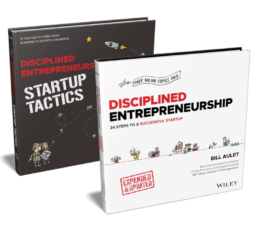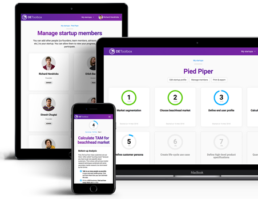Step 16
Pricing Framework
Pricing is primarily about determining how much value your customer gets from your product and capturing a fraction of that value back for your business.
Costs are irrelevant (except for setting a floor) in determining your pricing structure. You will be able to charge a higher price to early customers as opposed to later customers but be flexible in offering special, one-time-only discounts to select early testers and lighthouse customers, as they will be far more beneficial to your product’s success. Unlike your Business Model, pricing will continually change, both as a result of the information you gather and as you progress throughout the 24 steps, as well as in response to market conditions.
Videos
Worksheets
Examples
Content will be published as it becomes available.
Topics
Process Guide
It is virtually impossible to know your optimal price for your new product until you are able to offer it at scale and see how customers actually respond, as opposed to what they tell you they would hypothetically do. However, pricing is extremely important as even small pricing changes yield large direct effects on your profitability. As such, it is important to spend some good time on pricing now, but not too much, because it is foolhardy to think you can come up with accurate, detailed pricing at this early stage. Like with many other steps, this first pass on pricing is just a good educated guess to keep the process moving so you can continue learning; you will update and refine this step later.
In this step, you will come up with a reasonable pricing range aligned with the Business Model(s) you chose in Step 15, Design a Business Model. This framework will then be used to estimate the Lifetime Value (LTV) of a new average customer to your startup and will be the starting point for later market testing (specifically, some form of A/B testing).
There are six major criteria to consider when making the decision, some of which also factored into your decision on Business Model:
- Value Creation
You will base your pricing on the value you create for your customer, and not your costs. While it greatly depends on the strength of your Core, think of 20% of the value created as a good starting point for what you can fairly capture.
- Customer Acquisition Analysis
- Revisit Step 12, Determine the Customer’s Decision-Making Unit (DMU), and Step 13, Map the Process to Acquire a Paying Customer. What is the DMU and the process? What does that analysis tell you?
- Understand what authorization limits exist for the person who pays you, and try to stay below them so you decrease friction in the sales process. If your economic buyer, who clearly understands your value proposition, can’t make a purchase of $1,000 without running it by a vice president who is removed from the purchase process and will need persuading, then seriously consider pricing at $999 or lower.
- Nature of the Customer
Understand how the elasticity of demand, or willingness to pay, depends on the type of customer. Using Geoffrey Moore’s guide from Crossing the Chasm, customers typically fall into one of five groups, each of whom will respond differently to different prices:
- Technological enthusiast—buys based on technology coolness and as such is price inelastic and buys in low volume.
- Early adopter—buys based on ego because he or she wants to be first and show off and as such the price is inelastic and buys in low volume.
- Early majority—buys based on compelling return on investment [ROI] and as such is willing to take risks if the reward is high enough and will buy in relatively large volume and be influential.
- Late majority—buys based on ROI but is willing to take less risk, will buy a good volume, and as such is influenced by the success of early majority customers, which de-risked the product for the late majority; when this type finally buys, it will buy in relatively large volume.
- Laggard—buys based on a defensive position because to not buy is now risky because everyone else is buying, and seeks to avoid risk above all else; as such, when this type finally buys—which will be late—it will buy in relatively medium volume.
- Strength of Your Core
Your Core will be critically important in your ability to command a premium price. As it grows over time, so will your power to command higher prices and give out fewer discounts.
- Competition
Awareness of competitive options (from the eyes of the customer, not you) is an important data point to consider in this process.
- Maturity of Your Product
- Is your product new to the market, or is it a mature product that may have even been proven in other markets?
- The former is high risk and hence harder to command a pricing premium; there is less risk in the latter, which affects not only list pricing but your ability to avoid having to discount.
- Flexibility early on, especially to get those key lighthouse customers or influential customers, is critical, and you should be willing to decrease your price in such scenarios. In such cases, customize the offering and include a confidentiality clause in the agreement with the customer with regard to the pricing so you don’t set a dangerous precedent and have to provide discounts to other customers, too.
- When you start going after follow-on markets, your success in other markets will allow you to price with fewer discounts than with your beachhead.
Remember it is easier to drop the price than to raise it, but that does not mean you should always start high and drop the price over time. In some cases, exactly the opposite is the better strategy, particularly with companies that have a short time window to achieve a Core of network effects.
There is also a tremendous amount of behavioral economics involved in pricing, especially for consumers. It is worth reading books and blogs on this topic. One of my favorites is Predictably Irrational by Dan Ariely. You should also learn more about A/B testing so that you have the fundamental skill needed to optimize pricing going forward.
After you complete your pricing analysis, you will probably be even less comfortable with the pricing decision than the Business Model decision. However, pricing is easier to change than Business Model, and you almost undoubtedly will change your pricing. Your goal for now is to make a first guess so you can analyze the unit economics for your product and see if they are viable to develop a scalable business. You’ll start that analysis with Step 17, Estimate the Lifetime Value (LTV) of an Acquired Customer.
Books
Content will be published as it becomes available.
Other Resources
Content will be published as it becomes available.
The Disciplined Entrepreneurship Toolbox
Stay ahead by using the 24 steps together with your team, mentors, and investors.
The books
This methodology with 24 steps and 15 tactics was created at MIT to help you translate your technology or idea into innovative new products. The books were designed for first-time and repeat entrepreneurs so that they can build great ventures.

